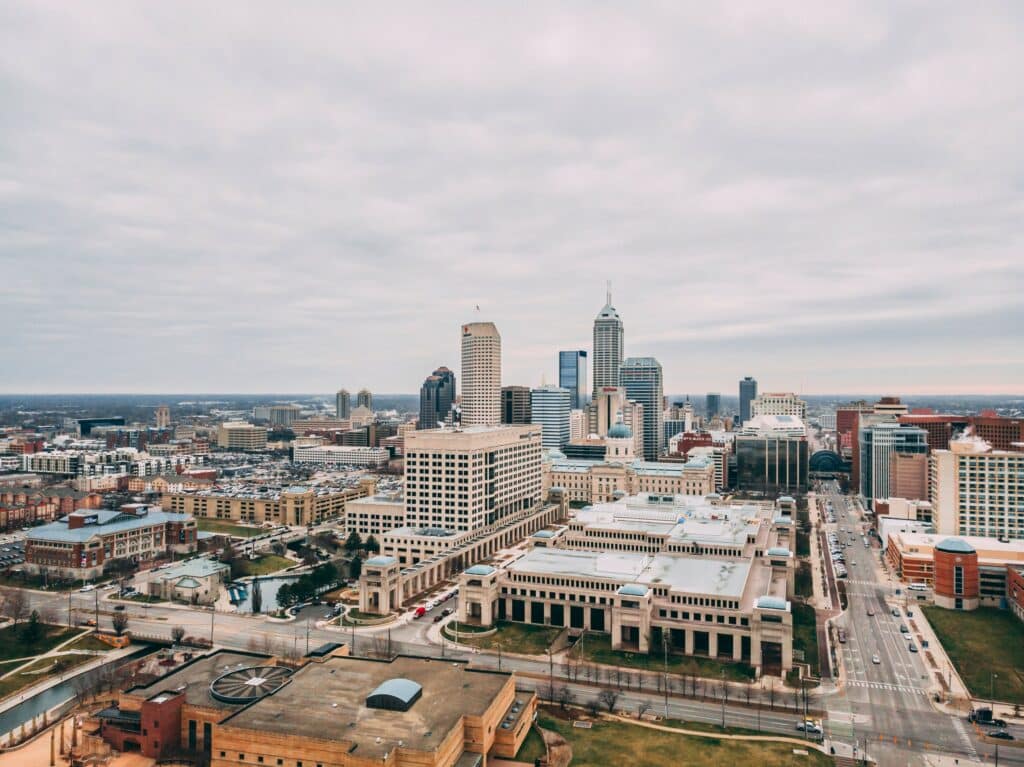Indiana Housing Market 2023 Report

What is the Indiana Housing Market Like?
Like most states across the country, the Indiana housing market has been increasing steadily for the past decade. However, the COVID-19 pandemic brought a sudden change of pace. As remote work became a widespread reality for many employees, allowing households to move further away from their place of employment to seek more affordable real estate prices and more living space, the demand for housing increased. At the same time, interest rates remained near historic lows. The Indiana housing market heated up in the months following the pandemic, with Indiana home prices increasing in the double digits in the year-over-year comparison. However, the Indiana housing market is showing signs of cooling down as mortgage rates have doubled since March 2022, following the Federal Bank’s announcement to use interest rate hikes as their primary means to fight back against galloping inflation.
According to data collected in October 2022, the latest available at the time of writing, the median Indiana sale price has reached $237,900, showing a 9.3% increase compared to its October 2021 level but a step down from double-digit growth observed in the months prior. Properties are selling fast, staying a mere 20 days on the market compared to 30 the year before. Inventory is tight, with 21,854 homes for sale in October 2022, 14.6% less than the year prior, and the housing inventory stands at a measly two months, up from one in October 2021, but a far cry from the five to six months needed for a balanced market according to real estate experts. Therefore, the Indiana housing market is competitive despite the sharp increase in mortgage rates, with 25.3% of listed homes selling above their asking price.

How does the Indiana Housing Market Compare with the National Housing Market?
Despite a cooling down of the real estate market, as marked by a 24.6% decline in the number of house sales in October 2022 compared to October 2021, the Indiana housing market is still going strong as the tight inventory cannot keep up with the demand. Between September 2022 and November 2022, approximately 7,000 Indiana residents were searching to move out of the state rather than moving in. Nevertheless, the housing inventory remains constrained, and home prices are still climbing, although at a slower pace. Therefore, Indiana home prices are faring better than other places across the country despite the sharp increase in interest rates.
The Federal Reserve Bank has initiated an aggressive monetary policy starting in March 2022 as a tool to slow down inflation, which stands at a 40-year high. As of December 2022, the interest rates for a 30-year fixed mortgage are hovering around 7%, twice as high as they were the year prior. As the cost of borrowing money got more expensive, the buying power of house hunters declined accordingly. Indiana home prices remain slightly lower than the national average.
Indiana Metro Areas with the Hottest Housing Markets
Indiana is one of the eight states that constitute the Great Lake Region and has inherited a strong manufacturing economy. Indiana has been the largest steel-producing state in the U.S. since 1975 and is also the 2nd largest auto-manufacturing state. Other manufacturing industries include pharmaceuticals and medical devices, automobiles, electrical equipment, transportation equipment, chemical products, rubber, petroleum, coal products, and factory machinery. Here are the Indiana metropolitan areas with the hottest housing markets in terms of volume.
- Indianapolis
- Fort Wayne
- Evansville
Indianapolis
With a population of 887,642 according to the 2020 US Census, Indianapolis – also known as Indy to the locals – is the capital and the most populous city in Indiana as well as the third-most populous city in the Midwest, after Chicago and Columbus, Ohio. Indianapolis’ economy relies primarily on the industries of trade, transportation, and utilities; professional and business services; education and health services; government; leisure and hospitality; and manufacturing. The Indianapolis housing market is still extremely hot despite the recent interest rate increases. Listed properties receive three offers on average and sell after a median number of days on the market of 14. 24.5% of houses for sale sold above the asking price in October 2022, and property prices are still increasing, with the median sale price climbing to $226,500, 5.6% higher than in October 201.
Fort Wayne
With a population of 263,886 as of the 2020 Census, Fort Wayne is the second-most populous city in Indiana after Indianapolis and the cultural and economic center of northeastern Indiana. Once part of the Rust Belt, Fort Wayne has undergone significant economic changes in the 21st century and diversified its economy to include distribution, transportation, and logistics; healthcare, professional and business services; leisure and hospitality, and financial services, as well as the defense industry, which is one of the leading employers. The housing market in Fort Wayne is extremely hot, with multiple offers and waved contingencies being the norm despite the sharp increase in interest rates. In October 2022, Fort Wayne home prices were up 11.8% compared to last year, selling for a median price of $190,000 and getting snatched off the market after a mere seven days.
Evansville
Evansville has a population of 118,414 at the 2020 census, making it the state's third-most populous city after Indianapolis and Fort Wayne, as well as the largest city in Southern Indiana. Evansville anchors a regional economic hub based primarily on trade, transportation, and utilities; professional and business services; education and health services; government; leisure and hospitality; and manufacturing. The housing market in Evansville is still white hot. In October 2022, Evansville home prices were up 4.4% compared to last year, selling for a median price of $144,000. Multiple offers situations are common, and properties go pending after a median number of seven days on the market.
Higher Mortgage Rates Could Slow Down the Price Growth in Indiana
As the cost of borrowing money has increased significantly and property prices remain high, the average mortgage has increased by tens of thousands of dollars, significantly affecting the buying power of would-be homebuyers. Therefore, many of them have found themselves pushed to the sidelines or are considering putting their house-hunting plans on the back burner until the tides turn. However, the Federal Reserve Bank has already announced that it will consider several more interest rate increases until the inflation hits a 2% target rate. Therefore, it is likely that mortgage rates will keep increasing.
Indiana home prices have been kept high by the tight inventory and relatively affordable real estate values compared to the national average. However, it is likely that the Indiana housing market will undergo a correction. Indiana housing prices are still growing, but at a considerably slower pace than in months prior.
Key Market Stats for the Indiana Housing Market
According to October 2022 data, some of the key market stats for the Indiana housing market appear as follows:
- Median home price: $237,900 – a 9.3% Y.o.Y. increase.
- Home sales: 7,104 – 24.6% less than a year ago.
- Months supply of inventory: 2 – compared to 1 in October 2022.
- Mortgage rates as of December 1st, 2022: 6.49%
Indiana Historic Price Changes and Affordability
Indiana home prices have been consistently increasing in the past decade, with the past three years being marked by even more rapid growth. Nevertheless, Indiana housing prices have not seen the dramatic increases observed in other states and remain relatively affordable compared to the national average. The median home price has increased from $178,100 in October 2019 to $237,900 in October 2022, with a peak of $254,700 in June 2022, representing a 33.57% increase in 36 months.
Where other, more expensive states are seeing an increase in inventory as the demand dwindles under the combined pressure of high property prices, high interest rates, and the growing cost of living, the housing inventory is still not keeping up in Indiana. Nevertheless, price growth has slowed down and will likely stabilize as the inventory catches up with the demand.
Key Takeaways
- Indiana home prices have increased noticeably in the past three years, albeit at a slower rate than other states across the country, and remain relatively affordable despite the increase in interest rates.
- The housing inventory remains extremely tight, keeping property prices high. The Indiana housing market remains a seller’s market, with properties still selling extremely fast.
- Nevertheless, the growth of house prices in Indiana is noticeably slower than it has been in the past two years as potential homebuyers must contend with high property prices, high interest rates, and the specter of a recession looming on the horizon.
